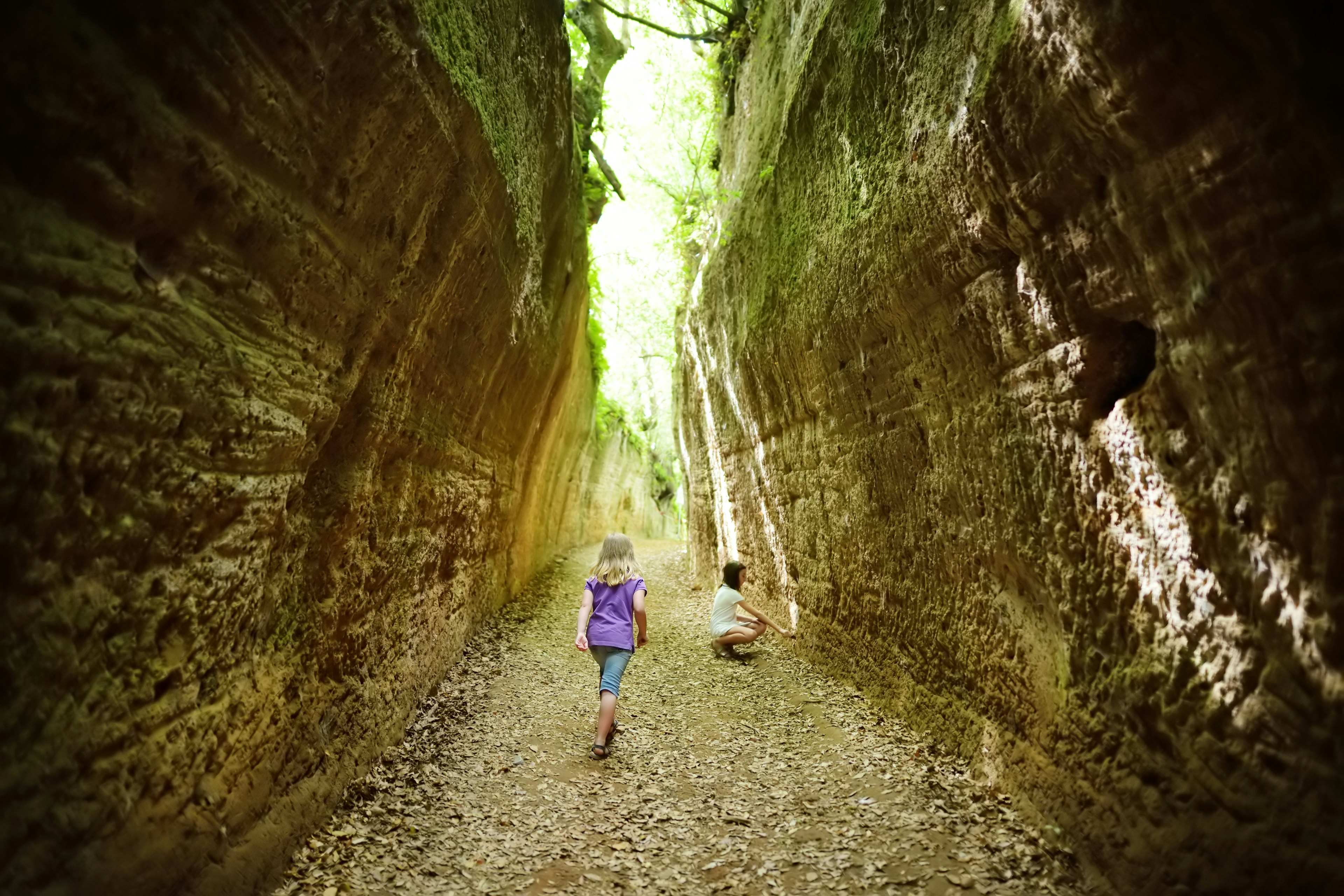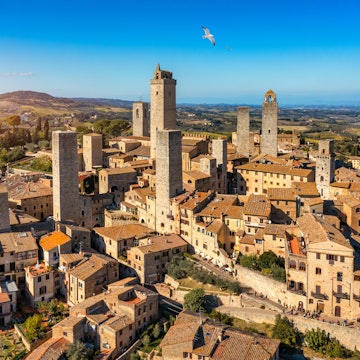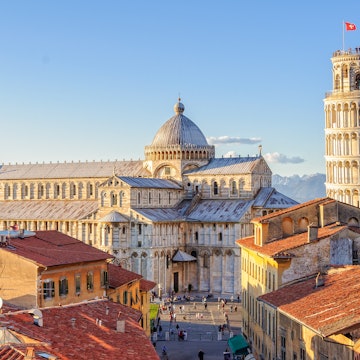
In the footsteps of the Etruscans: Italy’s top sites for discovering this ancient culture

Feb 28, 2022 • 5 min read

The Ara della Regina in Tarquinia, perhaps the best Etruscan site in Lazio © Marka / UIG via Getty Images
Long before the Romans rampaged onto the scene, the Etruscans had forged a powerful civilization in central Italy.
While little remains of this ancient people, if you head to the pitted, rugged hills of Tuscany, Umbria and northern Lazio, and you’ll find traces of what was once one of the Mediterranean’s great cultures.
Here is our guide to Italy’s top sites, museums and treasures that evoke the lost world of the Etruscans.
Who were the Etruscans?
The Etruscans dominated west-central Italy from the 8th to 4th centuries BCE. Their territory, Etruria, was centered on a confederation of 12 city-states in the area between the Arno and Tiber rivers.
Debate surrounds their origins: some scholars believe they migrated from Asia Minor; others maintain they were indigenous to the area. What is not disputed is that they developed a sophisticated society based on agriculture, trade and mining.
Much of what we now know about the Etruscans derives from findings unearthed in their elaborate tombs. Like many ancient peoples, they placed great emphasis on the treatment of their dead and built impressive cemeteries with richly decorated burial sites.
Start with an introduction to Etruscan artifacts in Rome
To whet your appetite for Etruscan adventures, take time to bone up at Rome’s Museo Nazionale Etrusco di Villa Giulia. This wonderful – and sadly often overlooked – museum showcases Italy’s finest collection of Etruscan and pre-Roman treasures in a graceful 16th-century villa. Its most celebrated piece is the Sarcofago degli Sposi (Sarcophagus of the Spouses), a 6th-century-BCE terracotta urn that was unearthed in Cerveteri.

The Etruscan necropolis at Cerveteri are eerie and evocative
Some 35km (22 miles) north of Rome, Cerveteri was a powerful Etruscan center from the 7th to 5th centuries BCE. Nowadays, its star turn is the Necropoli della Banditaccia, a veritable city of the dead with streets of haunting, Hobbit-like tumuli (circular tombs cut into the earth and capped by turf). Most of the tombs are unadorned, though you can still make out traces of painted reliefs in the Tomba di Rilievi.
Nearby, in Cerveteri’s compact historic center, further Etruscan treasures await at the Museo Nazionale Cerite. Chief among these is the Euphronios Krater, a celebrated 1st-century BCE vase that was long on display at New York’s Metropolitan Museum of Art before its restitution to Italy in 2008.
Orvieto lets you picture an early Etruscan city
Clifftop Orvieto, best known for its spectacular Gothic cathedral and medieval center, first came into its own as an important Etruscan city. The place known then as Velzna was one of the last Etruscan centers to succumb to the Romans in the 3rd century BCE. Nowadays, Orvieto’s Etruscan roots are on display at the Museo Claudio Faina e Civico, whose important collection comprises stone sarcophagi, terracotta pieces and some amazing bronzeware.

The Etruscans were master painters – and Tarquinia shows just how
Tarquinia is our pick for the best of northern Lazio’s Etruscan towns. Its headline act is the 7th-century-BCE Necropoli di Monterozzi – though the museum, the Museo Archeologico Nazionale Tarquiniense, and charming medieval center are most worthy supporting players.
The necropolis is pitted with thousands of underground tombs, of which around 20 are open to the public, a handful boasting incredible, vivid frescoes. Particularly magnificent are the paintings in the Tomba della Caccia e della Pesca, the Tomba dei Leopardi and the Tomba della Fustigazione.
Extraordinary Etruscan artifacts lie in store at Chiusi
In Tuscany’s Etruscan heartland, Chiusi boasts a small but outstanding collection of ancient finds. Showcased in the Museo Archeologico Etrusco di Chiusi, these include a bevy of pottery, jewelry and cinerary urns (for cremation ashes) from between the 9th and 2nd centuries BCE. A standout is the extraordinary pietra fetida (sulfur stone), a funerary sphinx dating from the 6th century BCE.

Get to know Etruscan architecture at Sovana
Tuscany’s most significant Etruscan tombs are concentrated in the Necropoli di Sovana. The star here is the monumental Tomba Ildebranda, which preserves traces of carved columns and stairs. You can also investigate the Tomba dei Demoni Alati (Tomb of the Winged Demons) with its headless terracotta figure, the Tomba del Tifone (Tomb of the Typhoon), and the Tomba della Sirena.
The site also features several stretches of excavated Etruscan roads known as vie cave.
The museum at Volterra offers the best Etruscan galleries outside Rome
The walled Tuscan town of Volterra sports a largely medieval look – but take to its cobbled lanes and you’ll find evidence of its Etruscan origins. Most notably, the Porta dell’Arco gate dates to the 4th century BCE and survives from the original Etruscan walls.
The Museo Etrusco Guarnacci provides further testimony, showcasing a fascinating collection of artifacts. Highlights include the Urna degli sposi (Urn of the Spouses), a strikingly realistic rendering of an elderly couple, and L’Ombra della sera (Shadow of the Evening), an elongated bronze nude figurine.
The Etruscans lived their best coastal life at Populonia
Set atop a promontory on the Tuscan coast, the Parco Archeologico di Baratti e Populonia encompasses the remains of Etruria’s only seaside city. Trails snake through the verdant park leading to ruins and well-preserved prehistoric tombs such as the 28m-diameter (92ft) Tomba dei Cari in the Necropoli di San Cerbone.
Nearby, at the Acropoli di Populonia (settlement of Populonia) digs have unearthed the foundations of a 2nd-century-BC Etruscan temple, as well as remains of Roman temples, the city’s central square, some towering terracing and an evocative, roughly paved road.
You might also like:
This is how Italy is protecting its underwater cultural heritage
Insider tips for the best things to do in Italy
6 of the most beautiful road trips in Italy















